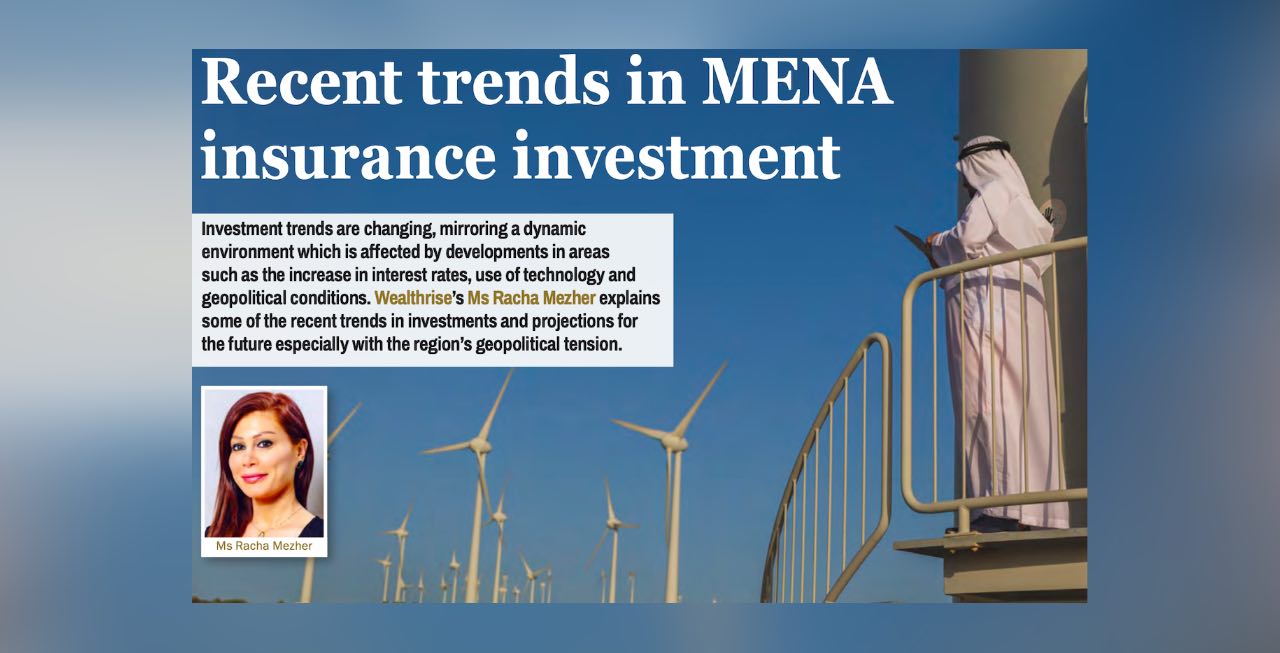
Recent Trends In Mena Insurance Investment
Each insurer adopts a distinct investment approach, resulting in varying asset allocations based on its specific objectives, risk appetite and prevailing market conditions. Recent trends highlight a movement toward sustainable, long-term investments, influenced by shifts in market dynamics, evolving regulatory frameworks and changing societal values.
Factors driving these allocation adjustments include the pursuit of higher fixed-income yields following interest rate hikes, diversification into private markets amidst economic uncertainties, and a growing emphasis on sustainable investment principles. Insurers diligently optimise their portfolios while navigating regulatory changes, data complexities, and market volatility.
Alternative investments
Recently, insurers have been increasingly investing in private equity funds and direct private company investments to diversify portfolios and achieve higher returns. In addition, they are expanding their real estate investments, particularly in commercial and residential properties, aiming for asset diversification and stable income streams.
Besides, insurers allocate capital to infrastructure projects, such as renewable energy, transportation, and utilities. These long-term investments align well with insurers’ liabilities and serve as a hedge against inflation.
Insurers also channel more funds into technology-driven sectors like fintech, healthcare tech, InsurTech, and cyber security. Venture capital investments in disruptive start-ups gain prominence as insurers adapt to evolving market dynamics.
Sustainability factors also play a central role in insurers’ investment decisions. Green bonds, sustainable infrastructure, and companies with robust ESG practices are on the rise. Integrating ESG considerations helps mitigate long-term risks and seize emerging opportunities.
Divesting equities
Some insurers are reducing exposure to public equities, especially in traditional sectors like banking and finance, aiming to optimise returns while managing risk. Other areas insurers may divest from include fixed-income assets as interest rates rise and yields become less attractive. Optimising core fixed income portfolios is a priority.
They might also reduce exposure to commodities due to price fluctuations and increased volatility; high fees and volatile performance lead some insurers to decrease hedge fund investments; insurers optimise returns and risk management by reducing exposure to alternative credit investments. Additionally, many insurers divest from coal, oil, and gas industries as part of their commitment to combat climate change and align with global sustainability goals.
Other fields insurers are increasingly divesting from include tobacco and controversial weapons industries; traditional retail and office real estate; and traditional investment managers. While overall fixed income allocations remained relatively stable in 2022 due to unrealised losses, some insurers likely divested from equities as equity allocations decreased for P&C insurers.
Factors affecting investments
In the past two years, several factors have significantly influenced the investment trends of insurance companies.
Rising interest rates have allowed insurers to optimise their core fixed income portfolios; however, they have also negatively impacted asset values on insurers’ balance sheets. The increase in bond yields has prompted insurers to reallocate their fixed income holdings to benefit from these improved returns.
Significant global regulatory changes are anticipated, presenting compliance challenges but also potential investment opportunities. Stricter capital requirements and solvency regulations influence insurers’ asset allocations, pushing them towards investments that require lower capital charges, such as government bonds and high-quality corporate bonds.
A growing trend of insurers increasing allocations to private market investments like private equity, infrastructure, and real estate. Private markets offer potential for higher returns compared to traditional public market assets, but they also come with added complexity.
Focus on sustainable investments as insurers already considering sustainability factors. Yet, despite the growing focus on ESG investments, data standardisation remains a concern, affecting the evaluation and comparison of sustainable investments.
Insurers are exploring investments in InsurTechs and technology solutions to drive efficiency, enhance data management capabilities, and adapt to changing customer preferences and distribution models.
High inflation rates have prompted insurers to seek investments that can act as inflation hedges, such as equities and real assets. The uncertain economic climate has driven insurers to diversify their portfolios and seek stable, long-term investments like infrastructure and real estate.
Market volatility has influenced insurers to adjust their equity exposures, balancing between capturing growth opportunities and managing downside risks. Increased use of derivatives to hedge against market risks, such as interest rate changes and currency fluctuations, has become more prominent.
In search of higher yields, insurers have turned towards private markets, including private equity, private debt, and real estate investments, which offer better returns compared to traditional public market assets. Investments in private markets provide diversification benefits, reducing reliance on public market volatility.
The increasing aging population has led to greater demand for long- term care and retirement products, influencing insurers to invest in assets that match long-term liabilities. Insurers are adapting to changing consumer preferences by investing in new product lines and technologies that cater to evolving needs.
Global geopolitical events have impacted supply chains, influencing insurers to reassess their investment strategies and risk exposures. Geopolitical tensions have led to increased market instability, prompting insurers to seek safe-haven assets and diversify geographically.
MENA-specific impacts
The MENA region’s geopolitics have become increasingly complex, prompting insurers to integrate regional risks into their risk management frameworks.
The ongoing conflict in Gaza poses a significant threat to global security and is further complicating the geopolitical landscape:
- Geopolitical tensions can lead to currency fluctuations, affecting the value of investments and potentially impacting insurer’s financial
- The region’s volatility remains high, increasing the risk of unintended escalation into full-scale conflict and impacting insurers’ risk assessments. This sustained uncertainty affects financial markets, requiring insurers to navigate it carefully when making investment decisions.
- Regulatory changes: Governments may introduce new regulations or restrictions on insurance activities in response to conflict, which can impact insurers’ operations and
- Conflicts can lead to an increase in claims, potentially putting pressure on insurers’ reserves and
- Insurers may face challenges in obtaining reinsurance coverage due to the perceived risk associated with the region, leading to higher premiums or reduced capacity.
- Conflicts can lead to business interruption risks, as companies may be forced to suspend operations or relocate due to safety concerns, impacting insurers’ ability to provide coverage.
- Reputation risk: Insurers may face reputational damage if they are seen as being involved in or profiting from conflicts, which can affect their brand and business relationships.
In light of these developments, insurers must stay informed and adapt to changing circumstances to maintain resilience and continuity in their investments and risk management practices. Closely monitoring geopolitical developments and adjusting investment strategies and risk assessments accordingly is crucial for navigating this complex environment.
Regulation affects investments
Several major regulatory actions have significantly impacted insurers’ investment strategies in recent years. These regulations influence how insurers allocate their assets, manage risks, and ensure solvency.
Among several regulatory actions, Solvency II, launched in 2016, is one action that has major impact on investments, through risk-based capital requirements, asset-liability matching and diversification.
The introduction of IFRS17, effective from January 2023, is the most recent regulatory development for the insurance markets. The IFRS17 impact on investment is evident as the standard requires insurers to measure insurance liabilities at fair value, which may lead to greater volatility in financial statements. Insurers might adjust their investment portfolios to mitigate this volatility.
Moreover, the need for consistent and transparent reporting can influence insurers to invest in assets with more predictable cash flows and valuations.


